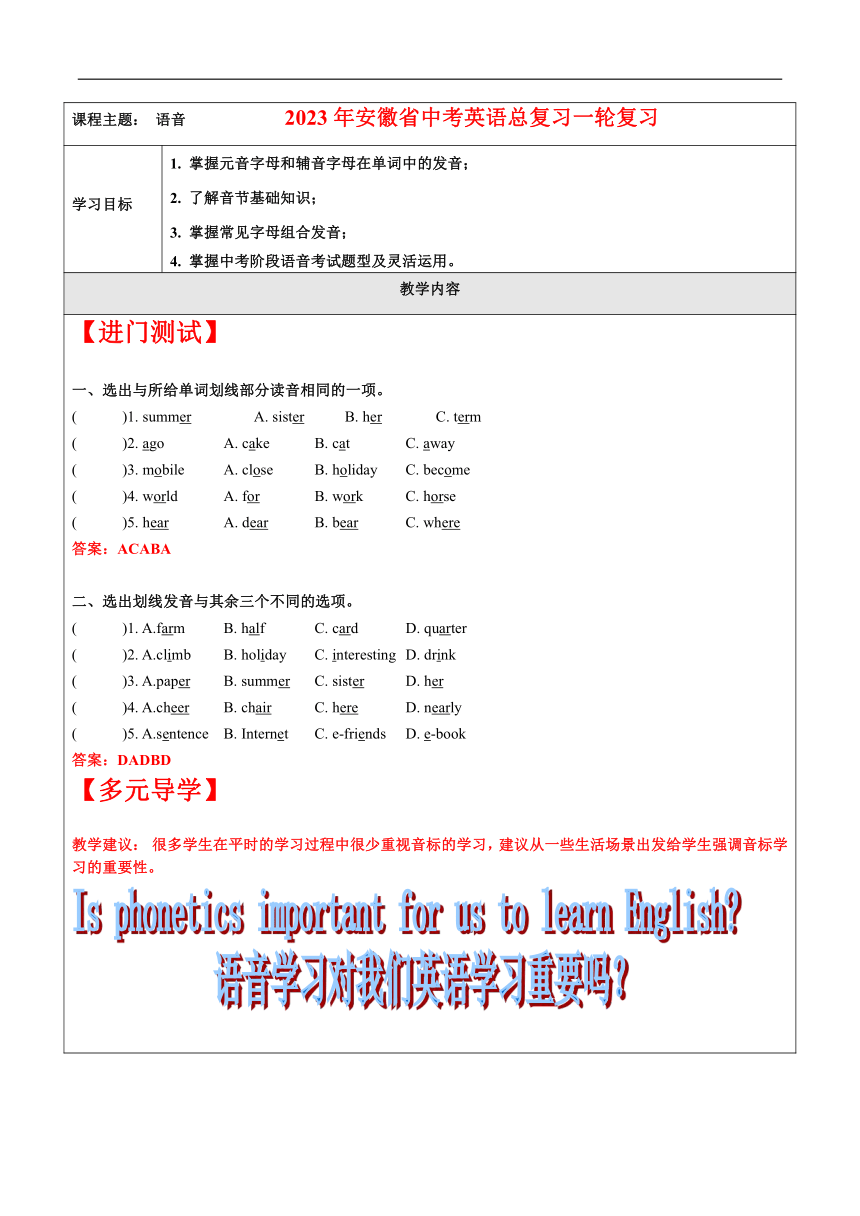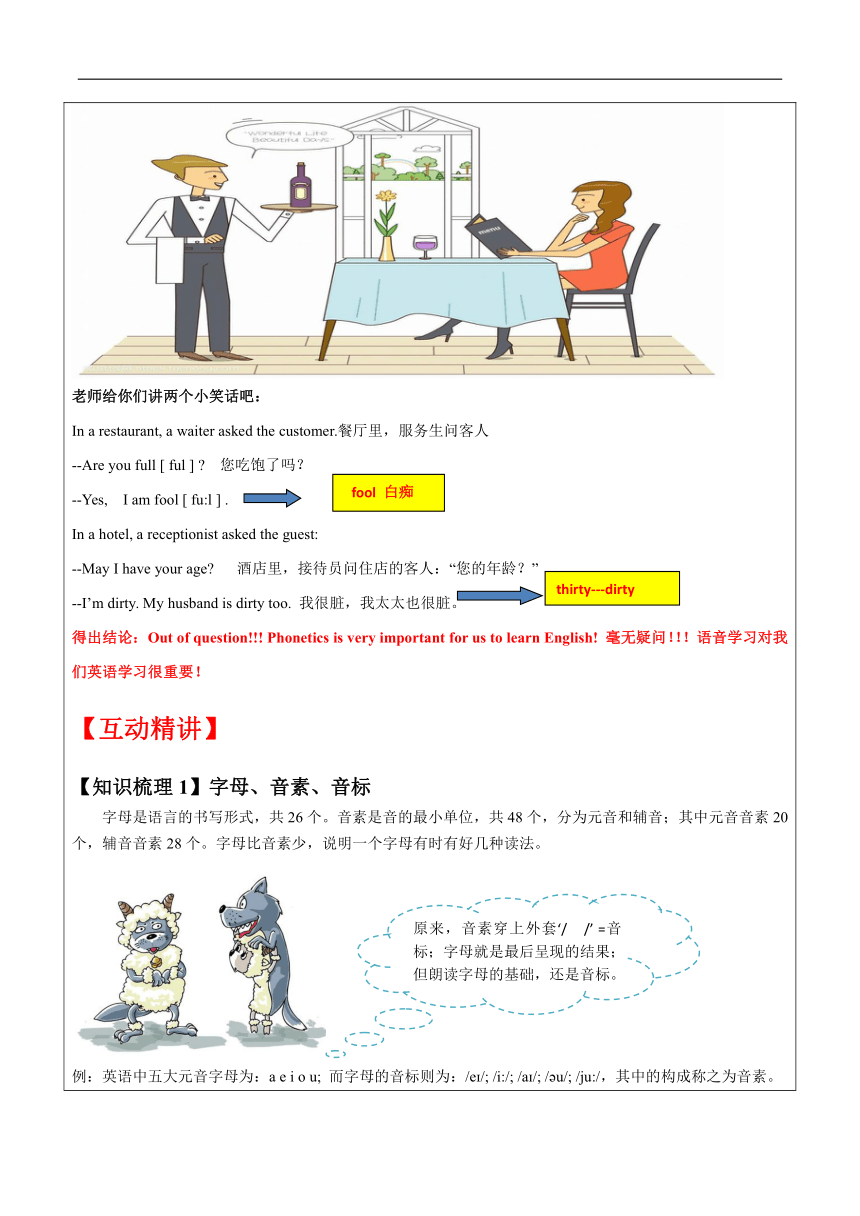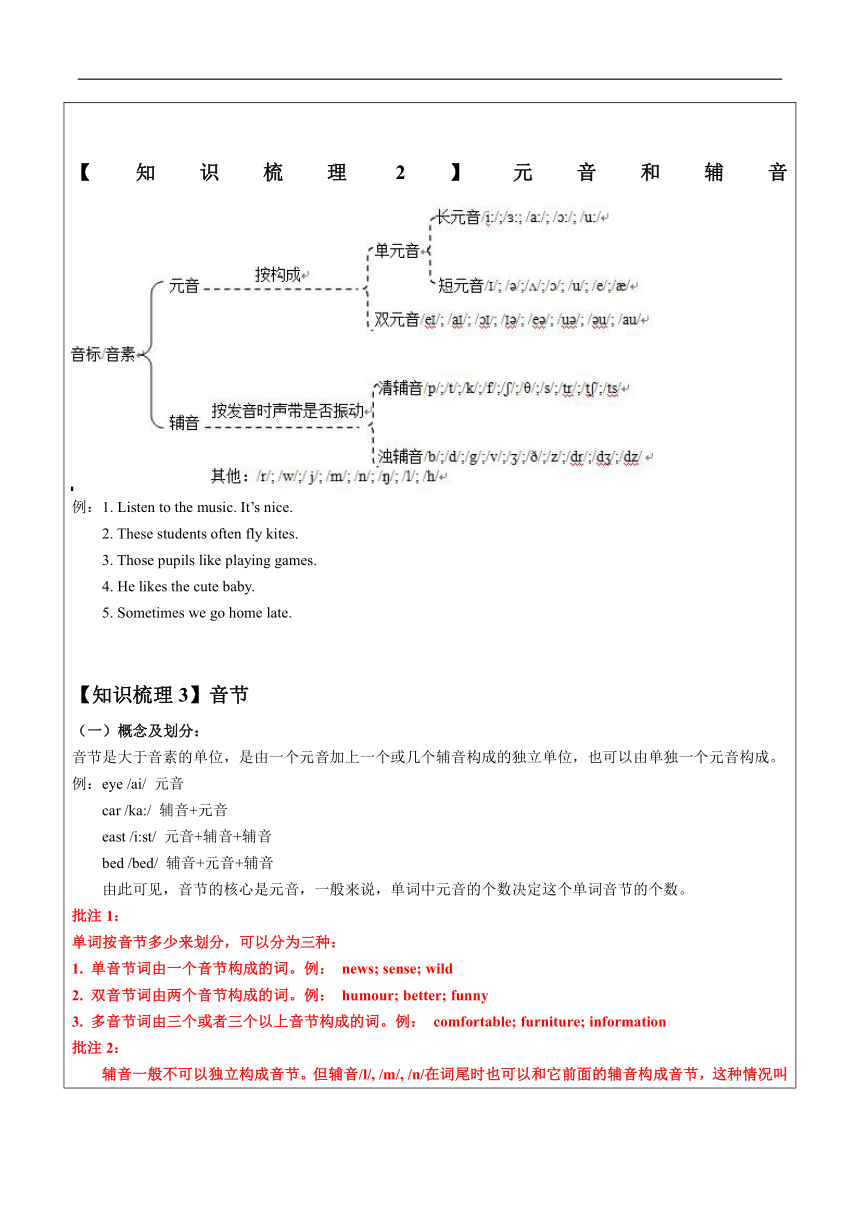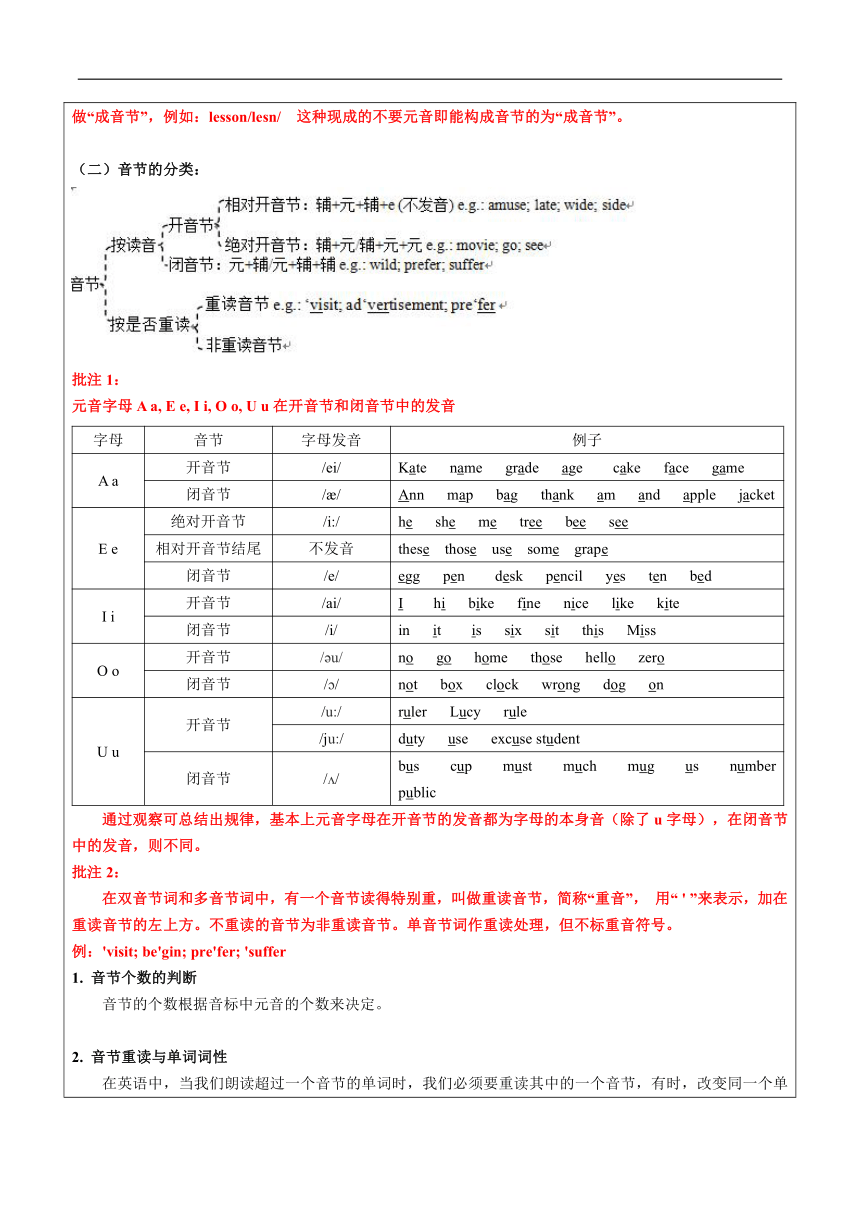2023年安徽省中考英语总复习一轮复习:第1讲-语音-教案
文档属性
| 名称 | 2023年安徽省中考英语总复习一轮复习:第1讲-语音-教案 |  | |
| 格式 | doc | ||
| 文件大小 | 352.5KB | ||
| 资源类型 | 教案 | ||
| 版本资源 | 通用版 | ||
| 科目 | 英语 | ||
| 更新时间 | 2023-04-18 17:21:19 | ||
图片预览





文档简介
课程主题: 语音 2023年安徽省中考英语总复习一轮复习
学习目标 1. 掌握元音字母和辅音字母在单词中的发音;2. 了解音节基础知识;3. 掌握常见字母组合发音;4. 掌握中考阶段语音考试题型及灵活运用。
教学内容
【进门测试】一、选出与所给单词划线部分读音相同的一项。( )1. summer A. sister B. her C. term( )2. ago A. cake B. cat C. away( )3. mobile A. close B. holiday C. become( )4. world A. for B. work C. horse( )5. hear A. dear B. bear C. where答案:ACABA二、选出划线发音与其余三个不同的选项。( )1. A.farm B. half C. card D. quarter( )2. A.climb B. holiday C. interesting D. drink( )3. A.paper B. summer C. sister D. her( )4. A.cheer B. chair C. here D. nearly( )5. A.sentence B. Internet C. e-friends D. e-book答案:DADBD【多元导学】教学建议: 很多学生在平时的学习过程中很少重视音标的学习,建议从一些生活场景出发给学生强调音标学习的重要性。老师给你们讲两个小笑话吧:In a restaurant, a waiter asked the customer.餐厅里,服务生问客人--Are you full [ ful ] 您吃饱了吗?--Yes, I am fool [ fu:l ] . In a hotel, a receptionist asked the guest: --May I have your age 酒店里,接待员问住店的客人:“您的年龄?”--I’m dirty. My husband is dirty too. 我很脏,我太太也很脏。得出结论:Out of question!!! Phonetics is very important for us to learn English! 毫无疑问!!!语音学习对我们英语学习很重要!【互动精讲】【知识梳理1】字母、音素、音标字母是语言的书写形式,共26个。音素是音的最小单位,共48个,分为元音和辅音;其中元音音素20个,辅音音素28个。字母比音素少,说明一个字母有时有好几种读法。例:英语中五大元音字母为:a e i o u; 而字母的音标则为:/e /; /i:/; /a /; / u/; /ju:/,其中的构成称之为音素。【知识梳理2】元音和辅音例:1. Listen to the music. It’s nice.2. These students often fly kites.3. Those pupils like playing games.4. He likes the cute baby. 5. Sometimes we go home late.【知识梳理3】音节(一)概念及划分:音节是大于音素的单位,是由一个元音加上一个或几个辅音构成的独立单位,也可以由单独一个元音构成。例:eye /ai/ 元音car /ka:/ 辅音+元音east /i:st/ 元音+辅音+辅音bed /bed/ 辅音+元音+辅音由此可见,音节的核心是元音,一般来说,单词中元音的个数决定这个单词音节的个数。批注1:单词按音节多少来划分,可以分为三种:1. 单音节词由一个音节构成的词。例: news; sense; wild2. 双音节词由两个音节构成的词。例: humour; better; funny3. 多音节词由三个或者三个以上音节构成的词。例: comfortable; furniture; information批注2:辅音一般不可以独立构成音节。但辅音/l/, /m/, /n/在词尾时也可以和它前面的辅音构成音节,这种情况叫做“成音节”,例如:lesson/lesn/ 这种现成的不要元音即能构成音节的为“成音节”。(二)音节的分类:批注1:元音字母A a, E e, I i, O o, U u在开音节和闭音节中的发音字母音节字母发音例子A a开音节/ei/Kate name grade age cake face game闭音节/ /Ann map bag thank am and apple jacketE e绝对开音节/i:/he she me tree bee see相对开音节结尾不发音these those use some grape 闭音节/e/egg pen desk pencil yes ten bedI i开音节/ai/I hi bike fine nice like kite闭音节/i/in it is six sit this MissO o开音节/ u/no go home those hello zero闭音节/ /not box clock wrong dog onU u开音节/u:/ruler Lucy rule/ju:/duty use excuse student闭音节/ /bus cup must much mug us number public通过观察可总结出规律,基本上元音字母在开音节的发音都为字母的本身音(除了u字母),在闭音节中的发音,则不同。批注2:在双音节词和多音节词中,有一个音节读得特别重,叫做重读音节,简称“重音”, 用“ ' ”来表示,加在重读音节的左上方。不重读的音节为非重读音节。单音节词作重读处理,但不标重音符号。例:'visit; be'gin; pre'fer; 'suffer1. 音节个数的判断音节的个数根据音标中元音的个数来决定。2. 音节重读与单词词性在英语中,当我们朗读超过一个音节的单词时,我们必须要重读其中的一个音节,有时,改变同一个单词的重音部分,会改变单词的词义。例:object为双音节单词,当重读在第一个音节时,是名词,意思是 “a thing”;当重读在第二个音节时为动词,意思是 “to say that you disagree with something”。3. 重读闭音节与单词双写:重读闭音节可以分开来看,所谓闭音节,是指元音后出现辅音字母,且以辅音字母结尾的单词;所谓重读,是指一个词有多个音节,有一个音节的读音会相对大些,重些;当这个单词为单音节单词,统一默认为重读。综合来看,重读闭音节只结构和拼写上(倒着数)满足辅音元音辅音,且构成的音节重读,则此单词需要构成现在分词和过去式甚至是名词时需要双写尾字母。(三)特殊发音规则1. 冠词the的发音例:the honest man; the old man; the NBA player —— / i/ the disabled; the comfortable sofa; the good news —— / /2. 清音浊化一个音在连贯发音中,由于受到邻近的音的影响而发生读音变化现象。清辅音/s/后再出现一个清辅音时,就要将这个清辅音读成相对的浊辅音,即清音浊化。清辅音/p//t//k//tr/等在/s/后重读时由送气音变为不完全送气音,即发其浊辅音/b//d//g//dr/, 但音标仍写成清辅音。如:总结:/p/--/b/ /t/--/b/ /k/--/g/ /f/--/v/ /s/-/z/ /θ/-/ / / /-/ / /ts/-/dz/ /t /-/d / /tr/-/dr/ 批注:s谐音“私”,即自私,是个很自私的辅音,自己送气,则不允许其他的清辅音送气,在其后的基本上都要变为浊音。(四)常见的字母组合发音组合ea/ i: / breathe seafood speak leave mean / e / breath breakfast weather headache 组合ee/i:/ meet street see bleed cheese agree组合ow/a / cowboy powerful wow cow flower down now town/ / growth rainbow window show know tomorrow row 组合ou/a / doubt outgoing aloud throughout playground cloudy sound sour housework cloud about/ / young country enough组合oa/ / boat coat road goal组合or/ :/ popcorn wore more form New York pork sports tomorrow/ / work word world housework worker/ / visitor doctor actor factory mirror组合all / :l/ softball baseball fall call / :/组合al/ :/ walk chalk always wall also组合ear / : / earth early learn/ / fear hear dear near clear year /e / pear wear swear 组合er/ / finger lawyer either drawer cooker computer matter remember yesterday slimmer over组合our/a / our hour/ / humour Harbour behaviour honour组合ai/e / rain rainbow wait paint e-mail train waitress 组合ay /e / maybe day way stay away today/ I / Sunday Monday Tuesday Wednesday Thursday Friday Saturday组合air /e / air chair stair hair pair 组合ere / e / there where/ I / here组合eer/ I / deer cheer beer 组合ar /a:/ harm harmony sharp march farm art warm park are card car hard market supermarket/ :/ warm towards 字母y/aI/ sky why type try buy bye by/I/ widely truly voluntary primary only duty lucky lively ready rainy windy pretty many any healthy salty factory /j/ yellow yet young yoghurt 组合 igh/ aI/ light right high night might (五) 特殊字母及字母组合的发音1. “s”的发音当我们将可数名词由单数变为复数,或者将动词由复数变为单数时,通常在其结尾加s或者es, 此时,结尾的发音有三种不同的方式:(1)当一个单词以/p/, /f/, /t/, /θ/, or /k/结尾时, ‘-(e)s’发音为/s/例: maps books months likes hopes talks pollutes(2)当一个单词以一个元音发音或者一个浊辅音发音(除了/z/; /d /; / /)结尾时, ‘-(e)s’发音为/z/例: says flowers eggs loves rides seems(3)当一个单词以/s/, /z/, / /, / /, /t /, /d /发音结尾时,‘-(e)s’发音为/ z/例: oranges horses watches organizes rises 2. “ed”的发音大多数动词的过去式形式都以 “ed”结尾,但是结尾的发音有三种不同的方式:(1)当一个单词以/p/, /f/, /s/, / /, /θ/, /t / /k/结尾时, ‘-ed’发音为/t/例: danced helped talked shopped(2)当一个单词以一个元音发音或者一个浊辅音发音结尾时, ‘-ed’发音为/d/例: played lived answered carried(3)当一个单词以/t/, /d/发音结尾时,‘-ed’发音为/Id/例: hated needed visited shouted3. “th”的发音★th位于词首时,可以从词性上判别其应有的读音。在名词、动词、形容词和数词中th发清辅音/θ/。如:thing, theatre, Thursday, think, thank, thirteen, thirty, third, thousand, thirsty,在代词和一些虚词(冠词,连词等)中th发浊辅音/ /。如:them, their, theirs, there, the, than, then★th位于词尾(或音节之尾)时,其读音多数是清辅音/θ/。如:bath, tooth, 等。只有在少数单词中,如:with 中读浊音/ /。 ★th在词中并且后面接er时,或者最后一个字母是不发音的e时,通常也发浊辅音/ /。如: weather, leather, father,等。在其他情况下发清辅音/θ/。例如: nothing, anything, healthy 【知识梳理3】句子的朗读运用句子重音、意群和停顿及升、降调来表意,注意连读和失去爆破(一)句子重音如:I 'like the 'black 'jeans. The 'blue 'ones aren’t 'long 'enough.Ex'cuse me, can you 'tell me the 'way to the 'hospital 'Yes.' Go 'straight a'head and 'turn 'left at the 'first 'crossing.(二)意群和停顿:在句子中间要停顿,在句子相对独立的意群之间也要作相应的停顿。如:1. My name’s Li Ming. || I’m from Shanghai. || I like English very much. || And I also enjoy swimming | and playing football. || If you want to go swimming | or play football with me, | just email me | or telephone me. || I will tell you my email address | and telephone number | after class. || And if any one of you | is interested in English, | we can email each other | and talk over the phone | in English.2. France is a leader in art and culture, too. || A lot of young students from different countries | go to France | to further their studies. || Every year, | French film festivals, | exhibitions | and concerts | are organized | all over the world.(三)升调和降调1. 陈述句陈述句会有较多变化,如:(1)Hello↗. Hello↘,Rose↗.(2)She's got long black hair↘.(3)I'd like chicken↗,chips↗ and salad↘,please↘.(4)It's a nice coat↘,but it's too expensive↘.(5)He was late for school yesterday↗ because he was ill↘.(6)If there is no rain↗,the animals will have no water to drink↘.2. 疑问句(1)一般疑问句:提问升调,回答降调,如:A:Have you ever been to the Century Park in Pudong↗ B:No↘,I haven't↘.(2)特殊疑问句:询问及回答都用降调,如:A:Where are you from↘ B:I'm from Shanghai↘.(3)选择疑问句,在前面的选择项升调,最后降调,如:Would you like coffee↗ or tea↘ 3. 祈使句:命令口吻常用降调,询问及请求常用升调,如:Turn off the light↘. Take a seat, please↗.4. 感叹句:降调,如:How beautiful the garden is↘!5. 情景中的应用,如:(1) A:Tom↘. B:Yes↗ A:May I borrow your bike↗ B:Yes↘, of course↘.(2) A:Will you go traveling with them next month↗ B:No↘, I won't↘. A:No↗ But why↘ (3) A:I'm sorry↘ I'm late↗. B:That's all right↗.(4) A:Three packets of biscuits, please↗. B:Sorry↗ How many↗ (四)连读1. /hɑ:f nau / half an hour 2. /'te k 't :z / Take it easy.3. /ka:nt u/ can’t you 4. /'pli:z'k p j t/ Please copy it.5. / 'kɑ:r v'h z n/ a car of his own 一、单词辨音,找出一个划线部分读音与其它不同的选项。1. A. who B. what C. where D. white2. A. late B. hat C. sale D. tape3. A. no B. so C. zero D. son4. A. kite B. nice C. five D. big5. A. late B. bake C. safe D. back6. A. white B. side C. hike D. kids7. A. coat B. nose C. show D. now8. A. sofa B. lamp C. flat D. palace9. A. post B. job C. local D. notice10. A. drive B. trip C. sign D. quite11. A. wheat B. east C. theatre D. beach12. A. forward B. postcard C. garden D. artist答案:1. A 2. B 3. D 4. D 5. D 6. D 7. D 8. A 9. B 10. B 11. C 12. A二、单项选择1. The underlined part in the word “create” is probably pronounced as .A. [i] B. [i:] C. [ei] D. [ ]2. The underlined part of the word “soup” is pronounced the same as that of the word ______ 学A.could B. sound C. group D. although3. The underlined part of the word “message” sounds ________. A. / / B. / / C. /e/ D. /e /4. The underlined part in the word “ suggestion” pronounces _______.A./ n / B. / t n / C. / t n / D. / t :n /5. The underlined word(划线单词) in the phrase(短语)”the animal” is pronounced ______.A. / / B. / i:/ C. /θi/ D. /θ /[来6. The phonetic transcription for the word “rang” is ______.A. / rI / B. / r / C. / re / D. / rΛ /7. Which of the following phonetic transcriptions is right for the “cold” A. /kold/ B. /k ud/ C. /kod/ D./k uld/ 8. Among the four underlined letters, which one has the different pronunciation from the other three A. boss B. police C. cotton D. nod9. The underlined part in the word “houses” is pronounced as .A. /SIS/ B. /θIS/ C. /SIZ/ D./ZIZ/10. The underlined part in the word “needed” is pronounced as ________.A. / t / B. / d / C. / id / D. / it /11. The underlined part in the word “says” is pronounced as ______. A. / es / B. / eIs / C. / ez / D. /eIz /12. The phonetic transcription for the word “of” is ______.A. / f / B. / f / C. / :f/ D. / v /13. The underlined part in the word “needed” is pronounced as ________.A. / t / B. / d / C. / id / D. / it /答案:1. C 2. C 3. B 4. B 5. B 6. B 7. D 8. B 9. D 10. C 11. C 12. D 13. C【课堂检测】一、单词辨音,找出划线部分读音不同的一项1. A. grow B. well-known C. now D. row2. A. pilot B. engineer C. rich D. attitude3. A. save B. travel C. lady[来 D. cake科网]4. A. dream B. exercise C. meat D. heat5. A. have B. as C. about D. active6. A. honest B. shock C. stone D. lost7. A. with B. think C. thank D. throw 8. A. how B. know C. now D. down9. A. deal B. treat C. dream D. deaf10. A. played B. planted C.visited D. started11. A. clever B. relax C. penguin D. never12. A. agree B. taxi C. Japanese D. camp13. A. pool B. cook C. look D. book14. A. thief B. with C. through D. thin15. A. photos B. toys C. plays D. banks答案:1.C 2.A 3.B 4.B 5.C 6.C 7.A 8.B 9.D 10.A 11.B 12.A 13.A 14.B 15.D二、单项选择1. The underlined part (划线部分) of “radio” is pronounced (发音) different from ______.A. sale B. April C. have D. table2.In the word“matches”,the underlined part is pronounced(发音) _______.A. |z| B. |siz| C. |iz| D. |ez|3.请根据所给音标/l t/,选择正确的单词。A. not B. lot C. long D. log4.和单词please的划线部分发音不相同的一项是 ________.A. meet B. these C. key D. they5.The underlined part of the word “medical” is pronounced as ________.A. | i | B. | | C. | ei | D. | ai |6.与字母N含有相同音素的字母是 .A. K B. M C. W D. Y7.Be sure not to miss this exhibition. The underlined part is pronounced as _____A. [t∫] B. [∫] C. [s] D. [z]8.下列哪组字母发音音素相同?A. FH B. GJ C. NX D. AY9.The underlined part in the word “succeeded” is pronounced as ______.A. / d / B. / id / C. / t / D. / tid / 10. 下列各项中含有 / i: / 发音的一项是 ________.A. Aa B. Ii C. Pp D. Hh答案:CCBDB BBCBC【要点回顾】【温故知新】课后巩固从A, B, C, D四个选项中选出划线部分读音与其它三个不同的一个。1. A. picks B. buys C. begins D. wears2. A. know B. window C. how D. show3. A. use B. bus C. music D. usually4. A. April B. paper C. map D. baby5. A. beach B. teach C. cheap D. machine6. A. face B. grandfather C. game D. lake7. A. yes B. seldom C. often D. never8. A. kite B. nice C. bridge D. child9. A. over B. hello C. phone D. front10. A. cute B. cup C. sun D. but11. A. read B. beautiful C. dream D. team12. A. cook B. noon C. noodle D. food13. A. ball B. walk C. always D. talk14. A. who B. which C. what D. where15. A. fan B. banana C. aunt D. angry答案:1--5 ACBCD 6--10 BCCDA 11--15 BACAD预习思考冠词的“冠”字,就是“帽子”的意思,请你思考以下几个问题:① 冠词是谁的帽子呢,名词、动词还是形容词的帽子?② 冠词本身有没有含义?可以单独存在吗?
fool 白痴
thirty---dirty
原来,音素穿上外套‘/ /’ =音标;字母就是最后呈现的结果;但朗读字母的基础,还是音标。
学习目标 1. 掌握元音字母和辅音字母在单词中的发音;2. 了解音节基础知识;3. 掌握常见字母组合发音;4. 掌握中考阶段语音考试题型及灵活运用。
教学内容
【进门测试】一、选出与所给单词划线部分读音相同的一项。( )1. summer A. sister B. her C. term( )2. ago A. cake B. cat C. away( )3. mobile A. close B. holiday C. become( )4. world A. for B. work C. horse( )5. hear A. dear B. bear C. where答案:ACABA二、选出划线发音与其余三个不同的选项。( )1. A.farm B. half C. card D. quarter( )2. A.climb B. holiday C. interesting D. drink( )3. A.paper B. summer C. sister D. her( )4. A.cheer B. chair C. here D. nearly( )5. A.sentence B. Internet C. e-friends D. e-book答案:DADBD【多元导学】教学建议: 很多学生在平时的学习过程中很少重视音标的学习,建议从一些生活场景出发给学生强调音标学习的重要性。老师给你们讲两个小笑话吧:In a restaurant, a waiter asked the customer.餐厅里,服务生问客人--Are you full [ ful ] 您吃饱了吗?--Yes, I am fool [ fu:l ] . In a hotel, a receptionist asked the guest: --May I have your age 酒店里,接待员问住店的客人:“您的年龄?”--I’m dirty. My husband is dirty too. 我很脏,我太太也很脏。得出结论:Out of question!!! Phonetics is very important for us to learn English! 毫无疑问!!!语音学习对我们英语学习很重要!【互动精讲】【知识梳理1】字母、音素、音标字母是语言的书写形式,共26个。音素是音的最小单位,共48个,分为元音和辅音;其中元音音素20个,辅音音素28个。字母比音素少,说明一个字母有时有好几种读法。例:英语中五大元音字母为:a e i o u; 而字母的音标则为:/e /; /i:/; /a /; / u/; /ju:/,其中的构成称之为音素。【知识梳理2】元音和辅音例:1. Listen to the music. It’s nice.2. These students often fly kites.3. Those pupils like playing games.4. He likes the cute baby. 5. Sometimes we go home late.【知识梳理3】音节(一)概念及划分:音节是大于音素的单位,是由一个元音加上一个或几个辅音构成的独立单位,也可以由单独一个元音构成。例:eye /ai/ 元音car /ka:/ 辅音+元音east /i:st/ 元音+辅音+辅音bed /bed/ 辅音+元音+辅音由此可见,音节的核心是元音,一般来说,单词中元音的个数决定这个单词音节的个数。批注1:单词按音节多少来划分,可以分为三种:1. 单音节词由一个音节构成的词。例: news; sense; wild2. 双音节词由两个音节构成的词。例: humour; better; funny3. 多音节词由三个或者三个以上音节构成的词。例: comfortable; furniture; information批注2:辅音一般不可以独立构成音节。但辅音/l/, /m/, /n/在词尾时也可以和它前面的辅音构成音节,这种情况叫做“成音节”,例如:lesson/lesn/ 这种现成的不要元音即能构成音节的为“成音节”。(二)音节的分类:批注1:元音字母A a, E e, I i, O o, U u在开音节和闭音节中的发音字母音节字母发音例子A a开音节/ei/Kate name grade age cake face game闭音节/ /Ann map bag thank am and apple jacketE e绝对开音节/i:/he she me tree bee see相对开音节结尾不发音these those use some grape 闭音节/e/egg pen desk pencil yes ten bedI i开音节/ai/I hi bike fine nice like kite闭音节/i/in it is six sit this MissO o开音节/ u/no go home those hello zero闭音节/ /not box clock wrong dog onU u开音节/u:/ruler Lucy rule/ju:/duty use excuse student闭音节/ /bus cup must much mug us number public通过观察可总结出规律,基本上元音字母在开音节的发音都为字母的本身音(除了u字母),在闭音节中的发音,则不同。批注2:在双音节词和多音节词中,有一个音节读得特别重,叫做重读音节,简称“重音”, 用“ ' ”来表示,加在重读音节的左上方。不重读的音节为非重读音节。单音节词作重读处理,但不标重音符号。例:'visit; be'gin; pre'fer; 'suffer1. 音节个数的判断音节的个数根据音标中元音的个数来决定。2. 音节重读与单词词性在英语中,当我们朗读超过一个音节的单词时,我们必须要重读其中的一个音节,有时,改变同一个单词的重音部分,会改变单词的词义。例:object为双音节单词,当重读在第一个音节时,是名词,意思是 “a thing”;当重读在第二个音节时为动词,意思是 “to say that you disagree with something”。3. 重读闭音节与单词双写:重读闭音节可以分开来看,所谓闭音节,是指元音后出现辅音字母,且以辅音字母结尾的单词;所谓重读,是指一个词有多个音节,有一个音节的读音会相对大些,重些;当这个单词为单音节单词,统一默认为重读。综合来看,重读闭音节只结构和拼写上(倒着数)满足辅音元音辅音,且构成的音节重读,则此单词需要构成现在分词和过去式甚至是名词时需要双写尾字母。(三)特殊发音规则1. 冠词the的发音例:the honest man; the old man; the NBA player —— / i/ the disabled; the comfortable sofa; the good news —— / /2. 清音浊化一个音在连贯发音中,由于受到邻近的音的影响而发生读音变化现象。清辅音/s/后再出现一个清辅音时,就要将这个清辅音读成相对的浊辅音,即清音浊化。清辅音/p//t//k//tr/等在/s/后重读时由送气音变为不完全送气音,即发其浊辅音/b//d//g//dr/, 但音标仍写成清辅音。如:总结:/p/--/b/ /t/--/b/ /k/--/g/ /f/--/v/ /s/-/z/ /θ/-/ / / /-/ / /ts/-/dz/ /t /-/d / /tr/-/dr/ 批注:s谐音“私”,即自私,是个很自私的辅音,自己送气,则不允许其他的清辅音送气,在其后的基本上都要变为浊音。(四)常见的字母组合发音组合ea/ i: / breathe seafood speak leave mean / e / breath breakfast weather headache 组合ee/i:/ meet street see bleed cheese agree组合ow/a / cowboy powerful wow cow flower down now town/ / growth rainbow window show know tomorrow row 组合ou/a / doubt outgoing aloud throughout playground cloudy sound sour housework cloud about/ / young country enough组合oa/ / boat coat road goal组合or/ :/ popcorn wore more form New York pork sports tomorrow/ / work word world housework worker/ / visitor doctor actor factory mirror组合all / :l/ softball baseball fall call / :/组合al/ :/ walk chalk always wall also组合ear / : / earth early learn/ / fear hear dear near clear year /e / pear wear swear 组合er/ / finger lawyer either drawer cooker computer matter remember yesterday slimmer over组合our/a / our hour/ / humour Harbour behaviour honour组合ai/e / rain rainbow wait paint e-mail train waitress 组合ay /e / maybe day way stay away today/ I / Sunday Monday Tuesday Wednesday Thursday Friday Saturday组合air /e / air chair stair hair pair 组合ere / e / there where/ I / here组合eer/ I / deer cheer beer 组合ar /a:/ harm harmony sharp march farm art warm park are card car hard market supermarket/ :/ warm towards 字母y/aI/ sky why type try buy bye by/I/ widely truly voluntary primary only duty lucky lively ready rainy windy pretty many any healthy salty factory /j/ yellow yet young yoghurt 组合 igh/ aI/ light right high night might (五) 特殊字母及字母组合的发音1. “s”的发音当我们将可数名词由单数变为复数,或者将动词由复数变为单数时,通常在其结尾加s或者es, 此时,结尾的发音有三种不同的方式:(1)当一个单词以/p/, /f/, /t/, /θ/, or /k/结尾时, ‘-(e)s’发音为/s/例: maps books months likes hopes talks pollutes(2)当一个单词以一个元音发音或者一个浊辅音发音(除了/z/; /d /; / /)结尾时, ‘-(e)s’发音为/z/例: says flowers eggs loves rides seems(3)当一个单词以/s/, /z/, / /, / /, /t /, /d /发音结尾时,‘-(e)s’发音为/ z/例: oranges horses watches organizes rises 2. “ed”的发音大多数动词的过去式形式都以 “ed”结尾,但是结尾的发音有三种不同的方式:(1)当一个单词以/p/, /f/, /s/, / /, /θ/, /t / /k/结尾时, ‘-ed’发音为/t/例: danced helped talked shopped(2)当一个单词以一个元音发音或者一个浊辅音发音结尾时, ‘-ed’发音为/d/例: played lived answered carried(3)当一个单词以/t/, /d/发音结尾时,‘-ed’发音为/Id/例: hated needed visited shouted3. “th”的发音★th位于词首时,可以从词性上判别其应有的读音。在名词、动词、形容词和数词中th发清辅音/θ/。如:thing, theatre, Thursday, think, thank, thirteen, thirty, third, thousand, thirsty,在代词和一些虚词(冠词,连词等)中th发浊辅音/ /。如:them, their, theirs, there, the, than, then★th位于词尾(或音节之尾)时,其读音多数是清辅音/θ/。如:bath, tooth, 等。只有在少数单词中,如:with 中读浊音/ /。 ★th在词中并且后面接er时,或者最后一个字母是不发音的e时,通常也发浊辅音/ /。如: weather, leather, father,等。在其他情况下发清辅音/θ/。例如: nothing, anything, healthy 【知识梳理3】句子的朗读运用句子重音、意群和停顿及升、降调来表意,注意连读和失去爆破(一)句子重音如:I 'like the 'black 'jeans. The 'blue 'ones aren’t 'long 'enough.Ex'cuse me, can you 'tell me the 'way to the 'hospital 'Yes.' Go 'straight a'head and 'turn 'left at the 'first 'crossing.(二)意群和停顿:在句子中间要停顿,在句子相对独立的意群之间也要作相应的停顿。如:1. My name’s Li Ming. || I’m from Shanghai. || I like English very much. || And I also enjoy swimming | and playing football. || If you want to go swimming | or play football with me, | just email me | or telephone me. || I will tell you my email address | and telephone number | after class. || And if any one of you | is interested in English, | we can email each other | and talk over the phone | in English.2. France is a leader in art and culture, too. || A lot of young students from different countries | go to France | to further their studies. || Every year, | French film festivals, | exhibitions | and concerts | are organized | all over the world.(三)升调和降调1. 陈述句陈述句会有较多变化,如:(1)Hello↗. Hello↘,Rose↗.(2)She's got long black hair↘.(3)I'd like chicken↗,chips↗ and salad↘,please↘.(4)It's a nice coat↘,but it's too expensive↘.(5)He was late for school yesterday↗ because he was ill↘.(6)If there is no rain↗,the animals will have no water to drink↘.2. 疑问句(1)一般疑问句:提问升调,回答降调,如:A:Have you ever been to the Century Park in Pudong↗ B:No↘,I haven't↘.(2)特殊疑问句:询问及回答都用降调,如:A:Where are you from↘ B:I'm from Shanghai↘.(3)选择疑问句,在前面的选择项升调,最后降调,如:Would you like coffee↗ or tea↘ 3. 祈使句:命令口吻常用降调,询问及请求常用升调,如:Turn off the light↘. Take a seat, please↗.4. 感叹句:降调,如:How beautiful the garden is↘!5. 情景中的应用,如:(1) A:Tom↘. B:Yes↗ A:May I borrow your bike↗ B:Yes↘, of course↘.(2) A:Will you go traveling with them next month↗ B:No↘, I won't↘. A:No↗ But why↘ (3) A:I'm sorry↘ I'm late↗. B:That's all right↗.(4) A:Three packets of biscuits, please↗. B:Sorry↗ How many↗ (四)连读1. /hɑ:f nau / half an hour 2. /'te k 't :z / Take it easy.3. /ka:nt u/ can’t you 4. /'pli:z'k p j t/ Please copy it.5. / 'kɑ:r v'h z n/ a car of his own 一、单词辨音,找出一个划线部分读音与其它不同的选项。1. A. who B. what C. where D. white2. A. late B. hat C. sale D. tape3. A. no B. so C. zero D. son4. A. kite B. nice C. five D. big5. A. late B. bake C. safe D. back6. A. white B. side C. hike D. kids7. A. coat B. nose C. show D. now8. A. sofa B. lamp C. flat D. palace9. A. post B. job C. local D. notice10. A. drive B. trip C. sign D. quite11. A. wheat B. east C. theatre D. beach12. A. forward B. postcard C. garden D. artist答案:1. A 2. B 3. D 4. D 5. D 6. D 7. D 8. A 9. B 10. B 11. C 12. A二、单项选择1. The underlined part in the word “create” is probably pronounced as .A. [i] B. [i:] C. [ei] D. [ ]2. The underlined part of the word “soup” is pronounced the same as that of the word ______ 学A.could B. sound C. group D. although3. The underlined part of the word “message” sounds ________. A. / / B. / / C. /e/ D. /e /4. The underlined part in the word “ suggestion” pronounces _______.A./ n / B. / t n / C. / t n / D. / t :n /5. The underlined word(划线单词) in the phrase(短语)”the animal” is pronounced ______.A. / / B. / i:/ C. /θi/ D. /θ /[来6. The phonetic transcription for the word “rang” is ______.A. / rI / B. / r / C. / re / D. / rΛ /7. Which of the following phonetic transcriptions is right for the “cold” A. /kold/ B. /k ud/ C. /kod/ D./k uld/ 8. Among the four underlined letters, which one has the different pronunciation from the other three A. boss B. police C. cotton D. nod9. The underlined part in the word “houses” is pronounced as .A. /SIS/ B. /θIS/ C. /SIZ/ D./ZIZ/10. The underlined part in the word “needed” is pronounced as ________.A. / t / B. / d / C. / id / D. / it /11. The underlined part in the word “says” is pronounced as ______. A. / es / B. / eIs / C. / ez / D. /eIz /12. The phonetic transcription for the word “of” is ______.A. / f / B. / f / C. / :f/ D. / v /13. The underlined part in the word “needed” is pronounced as ________.A. / t / B. / d / C. / id / D. / it /答案:1. C 2. C 3. B 4. B 5. B 6. B 7. D 8. B 9. D 10. C 11. C 12. D 13. C【课堂检测】一、单词辨音,找出划线部分读音不同的一项1. A. grow B. well-known C. now D. row2. A. pilot B. engineer C. rich D. attitude3. A. save B. travel C. lady[来 D. cake科网]4. A. dream B. exercise C. meat D. heat5. A. have B. as C. about D. active6. A. honest B. shock C. stone D. lost7. A. with B. think C. thank D. throw 8. A. how B. know C. now D. down9. A. deal B. treat C. dream D. deaf10. A. played B. planted C.visited D. started11. A. clever B. relax C. penguin D. never12. A. agree B. taxi C. Japanese D. camp13. A. pool B. cook C. look D. book14. A. thief B. with C. through D. thin15. A. photos B. toys C. plays D. banks答案:1.C 2.A 3.B 4.B 5.C 6.C 7.A 8.B 9.D 10.A 11.B 12.A 13.A 14.B 15.D二、单项选择1. The underlined part (划线部分) of “radio” is pronounced (发音) different from ______.A. sale B. April C. have D. table2.In the word“matches”,the underlined part is pronounced(发音) _______.A. |z| B. |siz| C. |iz| D. |ez|3.请根据所给音标/l t/,选择正确的单词。A. not B. lot C. long D. log4.和单词please的划线部分发音不相同的一项是 ________.A. meet B. these C. key D. they5.The underlined part of the word “medical” is pronounced as ________.A. | i | B. | | C. | ei | D. | ai |6.与字母N含有相同音素的字母是 .A. K B. M C. W D. Y7.Be sure not to miss this exhibition. The underlined part is pronounced as _____A. [t∫] B. [∫] C. [s] D. [z]8.下列哪组字母发音音素相同?A. FH B. GJ C. NX D. AY9.The underlined part in the word “succeeded” is pronounced as ______.A. / d / B. / id / C. / t / D. / tid / 10. 下列各项中含有 / i: / 发音的一项是 ________.A. Aa B. Ii C. Pp D. Hh答案:CCBDB BBCBC【要点回顾】【温故知新】课后巩固从A, B, C, D四个选项中选出划线部分读音与其它三个不同的一个。1. A. picks B. buys C. begins D. wears2. A. know B. window C. how D. show3. A. use B. bus C. music D. usually4. A. April B. paper C. map D. baby5. A. beach B. teach C. cheap D. machine6. A. face B. grandfather C. game D. lake7. A. yes B. seldom C. often D. never8. A. kite B. nice C. bridge D. child9. A. over B. hello C. phone D. front10. A. cute B. cup C. sun D. but11. A. read B. beautiful C. dream D. team12. A. cook B. noon C. noodle D. food13. A. ball B. walk C. always D. talk14. A. who B. which C. what D. where15. A. fan B. banana C. aunt D. angry答案:1--5 ACBCD 6--10 BCCDA 11--15 BACAD预习思考冠词的“冠”字,就是“帽子”的意思,请你思考以下几个问题:① 冠词是谁的帽子呢,名词、动词还是形容词的帽子?② 冠词本身有没有含义?可以单独存在吗?
fool 白痴
thirty---dirty
原来,音素穿上外套‘/ /’ =音标;字母就是最后呈现的结果;但朗读字母的基础,还是音标。
